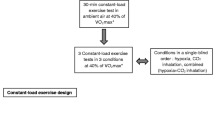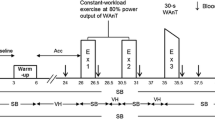Summary
Static relationships between arterial, transcutaneous[/p] and end-tidal PCO2 (P aCO2, P tc CO 2, P etCO2) as well as the dynamic relationship between P etCO2 and P tcCO2 were studied during moderate bicycle ergometer exercise with and without external C02 loading. The exercise pattern consisted of 5-min intervals of constant power at 40 W and 100 W and 900 s of randomised changes between these two power levels. The external CO2 loading was achieved by means of controlled variations of inspiratory gas compositions aimed at a constant P etCO2 of 6.5 kPa (49 mm Hg). The PetO2 was regulated at 17.3 kPa (130 mm Hg). Under steady-state conditions all PCO2 parameters showed close linear relationships. P aCO2/P tcCO2 was near to identity while the P etCO2 systematically overestimated changes in P aCO2. No relationship showed a significant influence of the exercise intensity. Transients of P tcCO2 are considerably slower than P etCO2 transients. The dynamic relationship between both parameters was found to be independent of whether internal or external C02 loadings were applied. It is concluded that the combination of P etCO2 and P tcCO2 measurements allows an improved non-invasive assessment of P aCO2. While P etC02 better reflects the transients, P tcCO2 can be employed to determine slow changes of the absolute P aCO2.
Similar content being viewed by others

References
Eßfeld D, Hoffmann U, Stegemann J (1987) VO2 kinetics in subjects differing in aerobic capacity: investigation by spectral analysis. Eur J Appl Physiol 56:508–515
Eßfeld D, Hoffmann U, Stegemann J (1990) Ventilatory effects of hypercapnic end-tidal PCO2 clamps during aerobic exercise of varying intensity. Eur J Appl Physiol
Phan CQ, Tremper KK, Lee SE, Baker SJ (1987) Noninvasive monitoring of carbon dioxide: a comparison of the partial pressure of transcutaneous and endtidal carbon dioxide with the partial pressure of arterial carbon dioxide. J Clin Monit 3:149–153
Rahn H, Farhi LE (1964) Ventilation, perfusion and gas exchange — the VA/Q concept. In: Fenn WO, Rahn H (eds) Handbook of physiology: respiration, vol 2. American Physiological Society, Washington, DC, pp 735–766
Scheid P, Piiper J (1980) Blood/gas equilibrium of carbon dioxide in lungs. A critical review. Respir Physiol 39:1–31
Severinghaus JW (1981) A combined transcutaneous PO2-PCO2 electrode with electrochemical HCO3-stabilization. J Appl Physiol Respir Environ Exerc Physiol 54:1027–1032
Severinghaus JW, Stafford M, Bradley AF (1978) tcPCO2 electrode design, calibration and temperature gradient problems. Acta Anaesthesiol Scand [Suppl] 68:118–122
Tremper KK, Shoemaker WC (1981) Continuous CPR monitoring with transcutaneous oxygen and carbon dioxide sensors. Crit Care Med 9:417–418
Tremper KK, Shoemaker WC, Shippy CR, Nolan LS (1981) Transcutaneous PCO2 monitoring on adult patients in the ICV and the operating room. Crit Care Med 9:752–755
Wimberley PD, Gronlund-Pedersen K, Thode J, Fogh-Anderson, Moller-Sorensen A, Sigaard-Andersen O (1983) Transcutaneous and capillary PCO2 and PO2 measurements in healthy adults. Clin Chem 29:1471–1473
Wimberley PD, Gronlund-Pedersen K, Olsson J, Sigaard-Andersen O (1985) Transcutaneous carbon dioxide and oxygen tension measured at different temperatures in healthy adults. Clin Chem 31:1611–1615
Author information
Authors and Affiliations
Rights and permissions
About this article
Cite this article
Hoffmann, U., Eßfeld, D. & Stegemann, J. Comparison of arterial, end-tidal and transcutaneous PCO2 during moderate exercise and external C02 loading in humans. Eur J Appl Physiol 61, 1–4 (1990). https://doi.org/10.1007/BF00236685
Accepted:
Issue Date:
DOI: https://doi.org/10.1007/BF00236685



